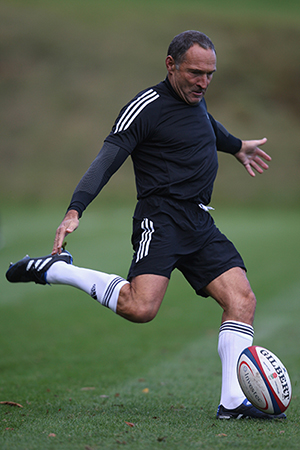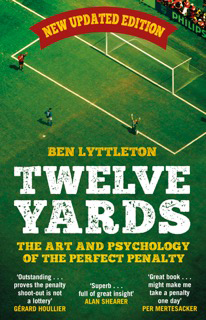 Dave Alred MBE PhD Elite Performance Coach
Every sport has its high-pressure moments: the penalty shoot-out in football, the 12-foot putt in golf, the second-serve to save the match in tennis. That’s the reason why we love it so much; we can glory in the triumph of athletic endeavour, but also pity the humanising failure of a professional unable to complete a task we spectators feel we could manage. Why else would we still talk about Gareth Southgate’s penalty miss in 1996, Dustin Johnson’s final-hole three-putt meltdown at the 2015 US Open, or Jana Novotna’s Wimbledon tears in 1993.
Dave Alred MBE PhD Elite Performance Coach
Every sport has its high-pressure moments: the penalty shoot-out in football, the 12-foot putt in golf, the second-serve to save the match in tennis. That’s the reason why we love it so much; we can glory in the triumph of athletic endeavour, but also pity the humanising failure of a professional unable to complete a task we spectators feel we could manage. Why else would we still talk about Gareth Southgate’s penalty miss in 1996, Dustin Johnson’s final-hole three-putt meltdown at the 2015 US Open, or Jana Novotna’s Wimbledon tears in 1993.
One man who could have helped all three athletes is Dave Alred OBE, the rugby union kicking coach whose methods helped Johnny Wilkinson kick England to World Cup success in 2003. Six years later, he worked with golfers.
As part of the research for my book Twelve Yards: The Art and Psychology of the Perfect Penalty, I sat down with him for an in-depth interview. “It is about the one-shot moment,” he told me. “You're the only one who is striking that ball; it’s all on you.”
One of his first clients was Luke Donald, who was ranked 32 when they started working together in January 2010. Alred introduced the following changes:
- he gave Donald a new competitive practice regime (ie, with pressure),
- he improved his posture and body language, and
- he taught him visualisation to create an air of inevitability about his shots.
“You have to rehearse all that, it’s about the processes that involve a certain mindset.” Over the next 18 months, Donald won six tournaments and had three top-11 finishes in the majors. He became world number one in May 2011 and stayed there for 40 weeks. They went their separate ways in September 2012 and in the next year, Donald’s world ranking dropped to 15 in the world.
Alred has also worked in football: first at Newcastle United, when Wilkinson was playing for the local rugby side, and at five other Premier League clubs.
Regardless of the sport, the first thing Alred tries to improve is the athletes’ technique. Not enough footballers, he believed, work specifically on their technique, just as golfers work day in, day out, on their swing. “Technique is such an important thing: you have to ask yourself, ‘Is it repeatable? Is this shot repeatable under pressure?’”
“Technique is such an important thing: you have to ask yourself, ‘Is it repeatable? Is this shot repeatable under pressure?’”
Then, add some pressure to training. For the penalty-kick scenario, he suggested: “For example, at any point in a training match, blow the whistle, penalty. One chance, one shot. Pressure. Carry on, and then, another penalty. Hit the hot spot. Pressure. At the end of the game, put two goalkeepers, not one, in goal, and get players to drive the ball hard to score. That will teach them to put power and accuracy on their shots. And if you score ten in a row in a competitive practise, then in the game, you will be more confident.”
Another part of my book research involved watching several Spaghetti western films. The reason was to understand the origins of the term ‘shoot-out’.
Alred had exactly the same idea and he surprised me when he showed a scene on his laptop from a movie I’d recently seen. “I’ve added subtitles to give it my own twist,” he said. It was from A Fistful of Dollars, when Clint Eastwood, whose character has no name, kills four Baxter brothers for shooting and laughing at his mule. “My mule don't like people laughing,” Eastwood said. “He gets the crazy idea you're laughing at him. Now if you apologise like I know you're going to, I might convince him that you really didn't mean it.” The brothers stayed silent. Eastwood shot them all.
I watched Alred’s interpretation of the scene. As Eastwood, a stranger, walks into the new town, he took in everything around him. Alred’s notes flashed up above the movie: ‘Dislocated Expectations: Plan, Rehearse, Visualise’. It was quickly apparent that the atmosphere was hostile and unpredictable.
Alred’s on-screen commentary: ‘Wide attention focus: Controlled, Total Awareness, Prepared’.
As he approached the four brothers, his head up, his back was straight and his gaze unwavering.
Alred: ‘Confident body language, Purposeful, Inevitable: Create Inevitability by Practising’.
 When Eastwood saw an extra brother sitting on a nearby fence, he revised his plan.
When Eastwood saw an extra brother sitting on a nearby fence, he revised his plan.
Alred: ‘Ready for Everything, Aggravation will not Impact my Performance’.
Then, the pre-shot routine.
Alred: ‘Total Focus on Your Relevant Cue’.
As the brothers lay dead on the ground outside the sheriff’s house, the final caption on Alred’s screen flashed up.
‘Are you an Apology or a Gunslinger?’
In Alred’s eyes, Jonny Wilkinson and Luke Donald were gunslingers; Southgate, Johnson and Novotna, at the time of their pressure moments, were not. The combination of technique, pressure preparation training, and composure all add up to the Eastwood ideal of the gunslinger. He is the master of performance under pressure. The shoot-out king. Think of him next time you see an athlete facing down that pressure moment.
The updated version of Twelve Yards is out now in paperback.
Rate and Review
Rate this article
Review this article
Log into OpenLearn to leave reviews and join in the conversation.
Article reviews